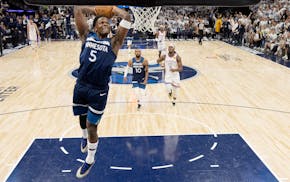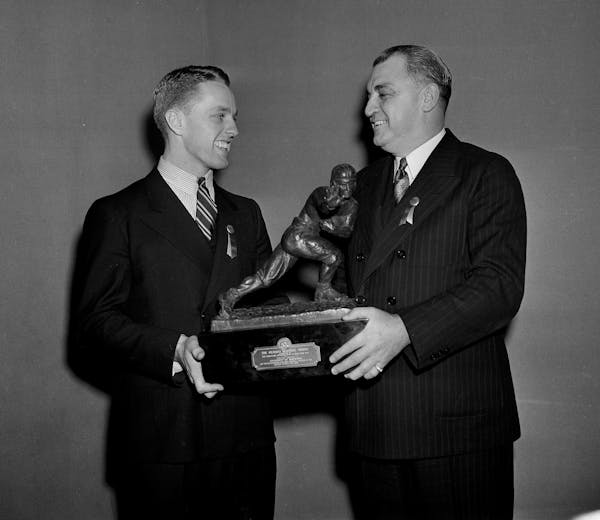The soft-spoken young man from Faribault, Minn., who had become a football star for the Golden Gophers, boarded the train Dec. 7, 1941, heading for more glory.
Bruce Smith had won the Heisman Trophy as a halfback and captain who overcame a serious knee injury, willing his team to a national championship. His plan was to pick up the Eversharp Award in Chicago before heading to New York for the Heisman ceremony.
But that first day of his trip, Japan attacked Pearl Harbor, changing everything.
America had been on the verge of entering World War II, with Adolf Hitler conquering Europe. Sports offered an escape from the gloomy front-page headlines. Joe DiMaggio had his 56-game hitting streak, Ted Williams batted .406, Whirlaway won horse racing's Triple Crown, and in Minnesota, Bernie Bierman's Gophers had just won a second consecutive national title.
But the 21-year-old Smith knew, intuitively, there was no escaping this news. Riding that eastbound train, he rewrote his Heisman acceptance speech with words that still resonate 75 years later.
"I think America will owe a great debt to the game of football when we finish this thing off," Smith said Dec. 9. "If 6 million American youngsters like myself are able to take it and come back for more … and fight hard for the honor of our schools, then likewise the same skills can be depended on when we have to fight like blazes to defend our country."
Smith's voice crackled over the national radio airwaves. Organizers had cut short the Heisman ceremony, starting it at 8:45 p.m., with President Franklin Roosevelt set to address the nation from the White House at 9.
"I'm very proud of that speech," Smith's oldest son, Bruce, said this fall. "He composed himself and gave a pep talk, essentially, to whoever was listening in the country."
Smith died in 1967 of intestinal cancer at age 47, leaving behind his wife, Gloria, and their four children.
The actual Heisman statue he won has a missing pinkie — funny story — and the family wound up selling the trophy in a 2005 auction to help with finances. But they are fiercely proud of everything he accomplished.
Smith carved his Minnesota legend in 1940 with an 80-yard touchdown run against Michigan that ranks as one of the most important plays in Gophers history.
Hyped by Collier's, the Saturday Evening Post and other publications as a preseason Heisman favorite in '41, Smith helped lead Minnesota to a second consecutive 8-0 season.
Smith remains the Gophers' only Heisman winner. To understand his impact, picture the combination of a running back, quarterback and safety. Starters played both offense and defense in those days, and Smith also punted for good measure.
Bierman's praise of his do-everything star still stands today: "My feeling in regard to Bruce is this — as a player, he did more to bring football glory to Minnesota than any player ever has."
Character revealed
Five years ago, near the 70th anniversary of Smith's Heisman, Susan Garwood of the Rice County Historical Society unearthed a gem.
Three decades earlier, Smith's father, Lucius, had donated boxes of memorabilia to the Faribault museum, including several reel-to-reel tapes. Sifting through the material, Garwood discovered an audio recording of Smith's Heisman ceremony.
Smith's children had never heard the speech.
"That was special," Garwood said. "It's not just Dad, it's a young Dad. It's one of his first big speaking moments, when his character is revealed, and he was a pretty profound man."
Smith saluted the Heisman's previous six winners, thanked his coaches and teammates, and confidently turned his attention toward Pearl Harbor.
"Those Far Eastern fellas may think that American boys are soft," Smith said, "but I have had, and even have now, plenty of evidence in black and blue to show that they are making a big mistake."
Scott Smith, the youngest child, was 10 when his father died. Hearing the speech for the first time gave him chills.
"I love the football stories," Scott said. "But I think it's Bruce Smith the man that I'm really proud of.
"So many people have come up to me and told me what a humble person he was. Grandma and Grandpa must have done a really good job raising him."
Run of the century
Born in 1920, Smith was the third of Emma and Lucius Smith's five vibrant children.
Lucius often brought his three sons to Gophers games, spurring their own dreams. At home, Bruce drew pictures of his Gophers football heroes — Butch Larson, Dick Smith, Pug Lund — sticking them to his bedroom closet.
Lucius and Smith's oldest sibling, George, had played for the Gophers, though not in starring roles.
Smith started as a sophomore in 1939, when the Gophers went 3-4-1. Bierman had steered Minnesota to three consecutive national titles from 1934-36, so fans were restless, wondering if the dynasty was faltering.
But the 1940 team had three College Football Hall of Famers — Smith, Dick Wildung and George (Sonny) Franck.
That November battle for the Little Brown Jug needed no hype, pitting No. 2 Minnesota against No. 3 Michigan in Minneapolis. Eventual Heisman winner Tom Harmon threw a touchdown pass, giving the Wolverines the lead, and a crowd of 60,481 shivered beneath wind-swept rain.
"I just remember it was a wet day," said Smith's youngest sibling, June, who watched with her family at Memorial Stadium, where tickets cost $2.75 apiece.
Her brother's No. 54 was barely visible with the mud. He stood in his leather helmet in the days before facemasks, a 6-foot, 195-pound force in Bierman's single-wing offense.
On the play of the day, if not the century, Sonny Franck took the snap at Minnesota's 20-yard line, heading right. Franck finished third in that year's Heisman voting, so the Wolverines crashed toward him. But he quickly handed the ball to Smith on the reverse.
Smith hit the hole, jetted through two linebackers, and made a breathtaking cut left to avoid another tackle, sprinting the final 60 yards untouched. The Gophers held on for a 7-6 triumph.
"Some seven Michigan players took their shots at Bruce … yet he kept those hard-driving legs churning and scored," Harmon later said. "It was a run that would have to be rated as one of the finest football has ever seen."
Afterward, instead of hanging around campus to bask in the adulation, Smith followed his postgame ritual — jumping in the family car for the 50-mile drive south to Faribault.
He had a hard time returning to campus that week, as the rain turned into mountains of snow from the infamous Armistice Day Blizzard. But there was no stopping the Gophers, who defeated Purdue and Wisconsin to finish the perfect season.
Smith was not an All-America selection that year, but his impact had been huge.
"He could run, kick and pass as a great halfback must," Bierman later said. "But in addition, he was one of the greatest blockers I have seen anywhere. And he was a perfect defensive player, no matter what defensive position he was required to play."
Unstoppable Smith
After being picked to captain the 1941 squad, no small honor in those days, Smith suffered a right knee injury that summer, working construction on the Faribault viaduct. Fans were relieved when the captain opened the season with two touchdown runs in a 14-6 win at Washington.
The midseason Michigan clash in Ann Arbor was another epic — No. 1 vs. No. 3. Smith had a 69-yard punt and threw a pass that moved the ball to the Michigan 5-yard-line, setting up the game's only touchdown.
But he reinjured his knee on the next play. One week after that 7-0 victory, Bierman tried using Smith as a decoy against Northwestern. The halfback took another hard hit and was carried off on a stretcher.
Trainers taped the knee into a bent position for the season's final three games against Nebraska, Iowa and Wisconsin. Smith came off the bench and made several critical plays in the 34-13 win at Iowa. Against Wisconsin, he broke free on rushes of 42 and 39 yards and completed three passes for 90 more. He also made an interception before reinjuring the knee, needing two trainers to help him off the Memorial Stadium field for the final time.
Smith finished as the team's third-leading rusher, but the last ovation told the story.
"The echoing, continuing roar of a standing crowd was testimony to the total adulation in which this modest, amazingly accomplished young athlete was held," authors Tom and Sam Akers wrote in their 1977 book, "The Game Breaker."
The Heisman vote count went 554 for Smith, 345 for Notre Dame's Angelo Bertelli and 336 for Frankie Albert of Stanford.
'The handsomest thing'
On Nov. 29, 1941, the day after learning he'd won the Heisman, Smith was back in his customary seat as the scoreboard operator for Faribault High School's basketball game against Waseca.
He loved spending time in his hometown, and the national hoopla didn't change that.
"He seemed to absorb it very well; he didn't become a Johnny Football, that's for sure," June Smith said, in reference to 2012 Heisman winner and noted partier Johnny Manziel.
Smith received airmail at his Pioneer Hall dorm from Paramount Pictures and Warner Bros. Football hero movies were in vogue. There had been a "Harmon of Michigan" movie, and Smith got $5,000 to play himself in "Smith of Minnesota."
"He was so embarrassed, he wouldn't let me see it," said Gloria Smith, now 93. "I caught it late on TV one night years later. It was awful. If they took the word 'swell' out of the dialogue, it would have been a silent movie."
Smith met Gloria while stationed in Philadelphia for the Navy, persuading her to marry him and move to Faribault.
"We talked and I thought he was probably the handsomest thing I'd ever seen in my life," she said.
With his knee surgically repaired, Smith continued playing football in the Navy, earning the 1942 National Service Player of the Year award. After the war, he spent four years in the NFL with the Packers and Rams.
He opened a sporting goods store in Northfield, then worked as a sales rep before moving the family to Alexandria, where he ran a Hamm's beer distributorship.
"I had someone tell me once, 'Well, he wasn't much of an entrepreneur,' " Gloria said. "He was very comfortable in his own skin. We always had a nice house. We belonged to the country club. We had four great kids and a lot of dogs. He took them hunting and fishing. I don't think he wanted anything else, and I didn't either.
"He died so young, but look what he accomplished."
Pinkie gone, trophy sold
Each Heisman award generates two trophies — one for the player and one for the school. The Gophers have their copy of Smith's Heisman on display at the Gibson-Nagurski Football Complex.
Smith's own trophy was a family centerpiece for years.
"We had a beautiful wooden mantle at the lake home [in Alexandria], and it sat there most of its life," Scott Smith said. "Before that, we had one of those old stereo consoles, and it was on there.
"One day, my mom was ironing Dad's shirts. After she finished, she would hang them from the Heisman. Apparently, she pulled too hard and lopped off a pinkie. She was just mortified."
When Gloria Smith downsized into a smaller home, there was no longer a logical showplace for the famous trophy. Plus, the bills were piling up, so the family auctioned it on Lelands.com. A Los Angeles businessman named Gary Cypres bought it for $395,000.
"I was collecting movie posters at the time," Cypres said. "What got me interested in Bruce Smith was the movie poster, 'Smith of Minnesota.' "
Cypres put Smith's trophy on display as part of his Sports Museum of Los Angeles, but that museum has since closed.
"It was a tough decision to see [the trophy] walk out the door," Scott Smith said. "But it was the right thing to do for our mother. It's been able to help her immensely."
Even without the trophy, the family has no shortage of tributes. William Cantwell, a Paulist priest from Alabama, even petitioned to have Smith canonized for sainthood. The family doesn't know what to make of that.
"But I don't think there will be another like him," Gloria said. "He was one of a kind. He went out like a prince."
The Star Tribune's Joel Rippel and John Wareham contributed to this story.
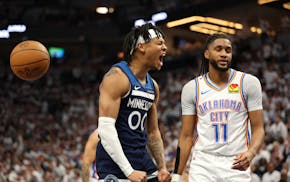
Timberwolves takeaways from Game 3: The game had barely begun and the Thunder were done
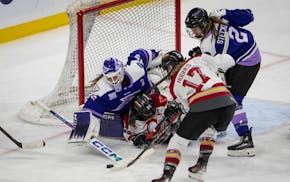
Neal: Frost goaltender Maddie Rooney stands tall — and stands up for her teammates on defense
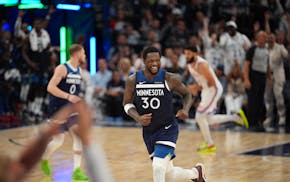
Live updates: Timberwolves respond in Game 3, hammer Oklahoma City

Minnesota United and Austin play to a 1-1 draw at Allianz Field
